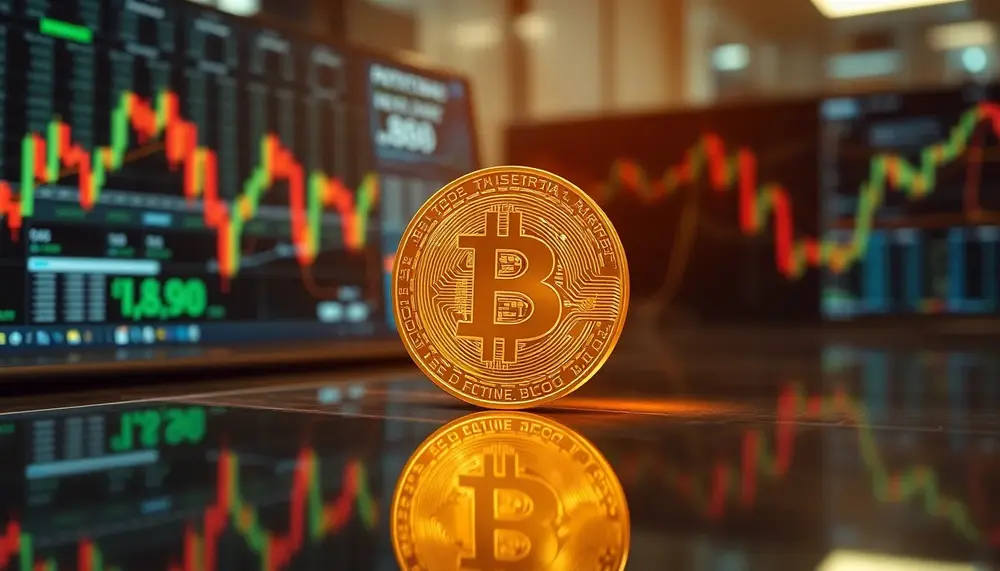Table of Contents:
Bitcoin's recent price swings and market turbulence have reignited debates about its role in the global financial ecosystem. From sharp declines and liquidations to long-term holders signaling potential sell-offs, the cryptocurrency market faces mounting pressure amid global economic uncertainty. Meanwhile, upcoming stablecoin legislation and Bitcoin's struggle to maintain its "digital gold" status add further complexity to the narrative. Dive into the full analysis to uncover the key drivers behind these developments and their implications for the future of crypto.
Bitcoin Faces Turbulent Times Amid Global Market Uncertainty
Bitcoin's price experienced a significant drop, hitting a low of $74,420.69 before rebounding to $78,146.03, according to CNBC. This marks a sharp decline from its Friday high of nearly $85,000 and a 28% drop from its January peak. The cryptocurrency market has been heavily impacted by global recession fears fueled by tariff tensions, with Bitcoin losing over $10,000 in value over the weekend. Ether and Solana tokens also saw losses of 13% and 10%, respectively.
David Hernandez, a crypto investment specialist at 21Shares, noted that Bitcoin's recovery above $78,000 was driven by traders reinvesting sidelined cash. However, the market remains volatile, with over $438 million in Bitcoin long liquidations recorded in a 24-hour period. Ether also faced $349 million in liquidations during the same timeframe. Analysts like Joel Kruger and Tracy Jin predict further potential declines, with Bitcoin possibly testing the $68,000 level.
"Today's relief rally has lifted Bitcoin ... with prices recovering above $78,000 as traders deploy the cash they moved to the sidelines," said David Hernandez, 21Shares.
| Metric | Value |
|---|---|
| Bitcoin Low | $74,420.69 |
| Bitcoin High | $85,000 |
| Bitcoin Liquidations | $438 million |
| Ether Liquidations | $349 million |
Key Takeaway: Bitcoin's price volatility continues amid global market turmoil, with significant liquidations and potential further declines predicted.
Long-Term Bitcoin Holders Signal Potential Sell-Off
According to TradingView, Bitcoin's price dropped to $74,604 before rebounding above $79,000. Despite this recovery, the cryptocurrency remains down 30% from its January peak of $109,000. A surge in the Exchange Inflow Coin Days Destroyed (CDD) metric indicates that long-term holders are moving their assets to exchanges, potentially signaling an intent to sell. Historically, such spikes have preceded major price corrections.
CryptoQuant analysts highlighted that short-term holders are also showing signs of capitulation, with realized price data reflecting losses. This trend mirrors patterns seen during previous market peaks, suggesting further downside risk. However, these metrics have also marked bottom zones in past bear cycles, offering a glimmer of hope for recovery.
- Bitcoin's current price: $79,000
- January peak: $109,000
- Exchange Inflow CDD spike: Potential sell-off signal
Key Takeaway: Long-term Bitcoin holders are moving assets, potentially indicating a sell-off, while short-term metrics suggest further market cooling.
Wall Street Braces for Crypto Legislation Impact
Forbes reports that Wall Street is preparing for significant changes as Congress debates new stablecoin legislation. The proposed bills could reshape the financial landscape by allowing or restricting interest payments on stablecoins. This has raised concerns about the potential impact on traditional banking, with some experts labeling it an "existential threat" to the financial system.
Stablecoins, led by Tether's $144 billion USDT, have gained traction as a bridge between traditional finance and crypto. However, the rapid growth of this market has sparked debates about regulation and its implications for both banks and crypto companies. Brian Moynihan, CEO of Bank of America, expressed interest in entering the stablecoin business if regulations permit.
"Stablecoins are emerging as the first real blockchain use case to be fully integrated into traditional finance," said Hina Sattar Joshi, TP ICAP.
Key Takeaway: The stablecoin market is at a crossroads, with upcoming legislation potentially transforming its role in the financial ecosystem.
Bitcoin's Role as 'Digital Gold' Under Scrutiny
Fortune highlights that Bitcoin's status as "digital gold" is being questioned as investors turn to physical gold during market turbulence. Despite its initial promise as a hedge against volatility, Bitcoin's recent performance has mirrored traditional risk assets. This has led to doubts about its utility beyond speculation.
Gold prices have risen as Bitcoin struggles, underscoring the challenges the cryptocurrency faces in establishing itself as a reliable store of value. Analysts suggest that Bitcoin's volatility and limited use cases continue to hinder its adoption as a true alternative to traditional assets.
Key Takeaway: Bitcoin's volatility and speculative nature are undermining its position as a safe-haven asset, with investors favoring physical gold during uncertain times.
Einschätzung der Redaktion
Die jüngsten Entwicklungen im Bitcoin-Markt verdeutlichen die anhaltende Unsicherheit und Volatilität, die Kryptowährungen prägen. Der starke Preisverfall und die hohen Liquidationen zeigen, wie empfindlich der Markt auf externe wirtschaftliche Faktoren reagiert. Die Bewegung von Vermögenswerten durch langfristige Halter auf Börsen signalisiert potenzielle Verkaufswellen, was die Unsicherheit weiter verstärken könnte. Gleichzeitig unterstreicht die Diskussion um Stablecoin-Regulierungen die wachsende Bedeutung von Kryptowährungen im traditionellen Finanzsystem, birgt jedoch auch Risiken für deren Integration. Bitcoin steht zudem vor der Herausforderung, seine Rolle als "digitales Gold" zu behaupten, da Investoren in Krisenzeiten weiterhin physisches Gold bevorzugen. Insgesamt bleibt der Markt in einer kritischen Phase, in der regulatorische Entscheidungen und Marktpsychologie eine entscheidende Rolle spielen werden.
Sources:
- Bitcoin drops to $74,000 before rebounding as cryptocurrencies join global market rout
- Whoopsie daisy Bitcoin!
- Long-Term Bitcoin Holders Are Moving Coins—Further Sell-Off Incoming?
- ‘Existential Threat’—Wall Street Suddenly Braced For A Bitcoin And Crypto Price Game-Changer
- US crypto stocks slip as bitcoin hits new 2025 low
- Bitcoin struggles to be ‘digital gold’ as scared investors choose real gold instead















